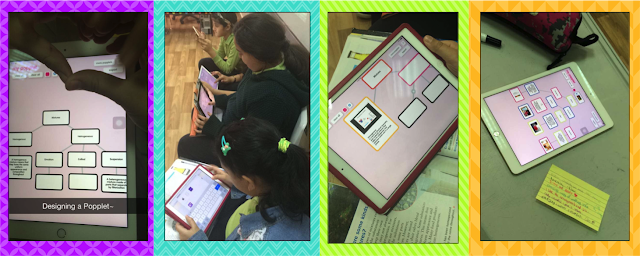What kind of learner are you? Are you auditory, visual, or kinesthetic? Different learning styles require different teaching and learning strategies in order for students to achieve deep learning. Furthermore, there are times where I need my students to visualize a concept in order to truly grasp it.
I can show them a graphic organizer... But I know it'll go "poof" the next day because they didn't actually construct it.
Or I can have them draw it... But I know that my slow learners will probably not construct it in time... And as for my perfectionists... They'll probably erase their lines and squares over and over again till they achieve that perfect straight line or that precise 90-degree angle.
The nice thing about living in our technically and digitally advanced 21st century is that I can rely on technological tools like Popplet in order to have my students enjoy creating graphic organizers and mind-maps.
My students recently used Popplet to create a graphic organizer that classifies different types of mixtures. Their task was to research and come up with a description of each type of mixture, along with uploading a picture as an example. They then presented their work during an Art Gallery activity and commented on each other's work.
My students love using Popplet! They don't have to worry about spending time positioning their lines and boxes on a sheet of paper. They can incorporate texts, videos, and links which make their graphic organizers more interactive. In the mixtures activity, using Popplet has helped them in making connections between the different types of mixtures. Most importantly, constructing their own graphic organizers enables them to easily consolidate any concept permanently in their mind. In my opinion, this app is perfect for targeting both visual and kinesthetic learners, and is a great tool for enabling students to visualize certain concepts.

I'm proud of my students' work and they truly amaze me each and everyday in all their accomplishments!
I can show them a graphic organizer... But I know it'll go "poof" the next day because they didn't actually construct it.
Or I can have them draw it... But I know that my slow learners will probably not construct it in time... And as for my perfectionists... They'll probably erase their lines and squares over and over again till they achieve that perfect straight line or that precise 90-degree angle.
The nice thing about living in our technically and digitally advanced 21st century is that I can rely on technological tools like Popplet in order to have my students enjoy creating graphic organizers and mind-maps.
My students recently used Popplet to create a graphic organizer that classifies different types of mixtures. Their task was to research and come up with a description of each type of mixture, along with uploading a picture as an example. They then presented their work during an Art Gallery activity and commented on each other's work.
My students love using Popplet! They don't have to worry about spending time positioning their lines and boxes on a sheet of paper. They can incorporate texts, videos, and links which make their graphic organizers more interactive. In the mixtures activity, using Popplet has helped them in making connections between the different types of mixtures. Most importantly, constructing their own graphic organizers enables them to easily consolidate any concept permanently in their mind. In my opinion, this app is perfect for targeting both visual and kinesthetic learners, and is a great tool for enabling students to visualize certain concepts.

I'm proud of my students' work and they truly amaze me each and everyday in all their accomplishments!







